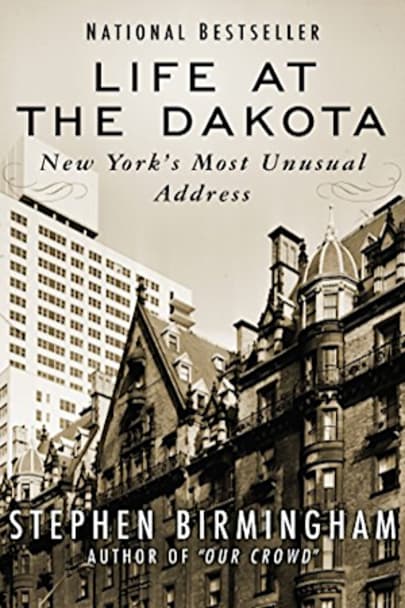A history of the Manhattan building and its famous tenants, from Lauren Bacall to John Lennon, by the New York Times–bestselling author of “Our Crowd”. When Singer sewing machine tycoon Edward Clark built a luxury apartment building on Manhattan’s Upper West Side in the late 1800s, it was derisively dubbed “the Dakota” for being as far from the center of the downtown action as its namesake … downtown action as its namesake territory on the nation’s western frontier. Despite its remote location, the quirky German Renaissance–style castle, with its intricate façade, peculiar interior design, and gargoyle guardians peering down on Central Park, was an immediate hit, particularly among the city’s well-heeled intellectuals and artists.
Over the next century it would become home to an eclectic cast of celebrity residents—including Boris Karloff, Lauren Bacall, Leonard Bernstein, singer Roberta Flack (the Dakota’s first African-American resident), and John Lennon and Yoko Ono—who were charmed by its labyrinthine interior and secret passageways, its mysterious past, and its ghosts. Stephen Birmingham, author of the New York society classic “Our Crowd”, has written an engrossing history of the first hundred years of one of the most storied residential addresses in Manhattan and the legendary lives lived within its walls.
more



Dated, but interesting.
Historically true
Not as good as I hoped
Repetitive and mostly boring
BOring. Skip it. Read the fictional The Dakota Winters instead. Charming.
Fascinating history of a wonderful, landmark building in NYC. Real-life characters that are kookier than fictional ones.
Great dish! It’s a bit weird reading about John and yoko a year before his death… But still interesting to learn how the building started in the farmland of uptown. The author loses steam toward the end.
Very interesting history about one of New York’s most iconic buildings.
I have read only a third of the book, but it tells about NY society from the early 1800’s. It explains how the Dakota was financed and built. It told about the residents of the Dakota as a different society compared to that if Mrs . Aster and her 400. One would have lived to meet some of the tenants. I’m thoroughly enjoying it
Incredibly consistent author. Well researched
Really enjoyed reading and learning about the history of the Dakota and how it mirrored what was going in New York’s history.
Very disappointing. And i have enjoyed this author’s other books. This was a boor. Might’ve made a good New Yorker magazine article but not enough meat for a book.
Enjoyed this book
This book brings the iconic Dakota to life. I always love history and this book does the job well.
Learned a great deal about this fascinating building. Probably will read again in a couple of years.
I’m quite surprised at how well I liked this book. I can’t say I have ever read a biography about a building, but it’s an interesting building with an interesting history. The book was published I believe in the 70’s. I was a little disappointed when I realized it wasn’t more recent, but in spite of that, it was a good read.
I enjoyed this read, taking off a star because of its frequent drifts into TMI. AT times, stories overlapped adding even more verbiage. But, this is a book worth reading; I didn’t even know of its existence despite walking in Central Park near the Museum nearby. Famous residents aside (John and Yoko Lennon and son Sean, Lauren Bacall, for example) the history of this building is fascinating, and its very substance and mutations take on a life of their own. Since the Dakota is in the Western part of NYC, it was once an outcast, yet a gentrified one, which evolved with the decades, sometimes in spite of them. I was unable not to finish it, just not all at one sitting. I am glad I did.
Dated material (some prominent tenants have long since passed–John Lennon for one). Interesting but lots of details about the administration of the place. The Dakota’s initial development in the late 19th century and the men behind it is a colorful, fascinating story as is the growth of New York in that period. But the narrative slows down. Interesting but tedious.
Somehow disappointing. Not that I want to know celebrities’ life secrets but with The Dakota as its centerpiece I expected more intrigue, more sizzle in this book. It’s as if the author signed privacy protection documents with the residents. Who knows? Maybe he did. If so he shouldn’t have written the book.
Ever since I saw it on a tour of New York City I’ve been fascinated with The Dakota. I’m also interested in John Lennon, and since our tour guide told us Yoko still lives there, I couldn’t wait to read this book. Even if you’re not a Lennon fan, you’ll still become absorbed in what it must be like to live in this unique building, the facade of which was shown in Rosemary’s Baby and other horror movies. My only disappointment was that it’s an old book; it was written before Lennon’s assassination, so you don’t really get a sense of what it’s like living there now. If you are fascinated with the lifestyles of the rich and famous, with New York history, or architecture in general, you’ll love this book.